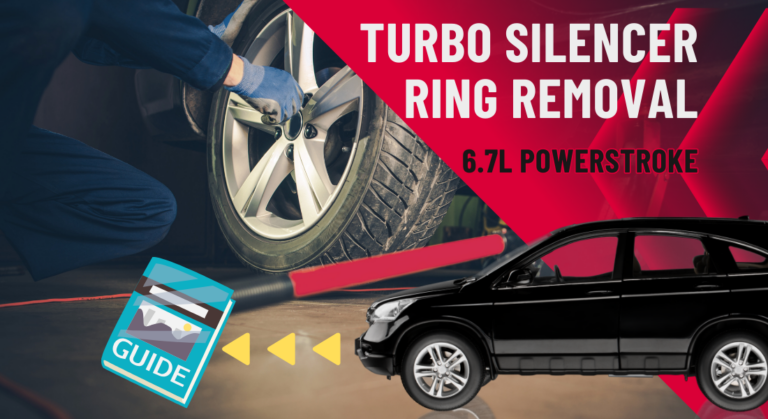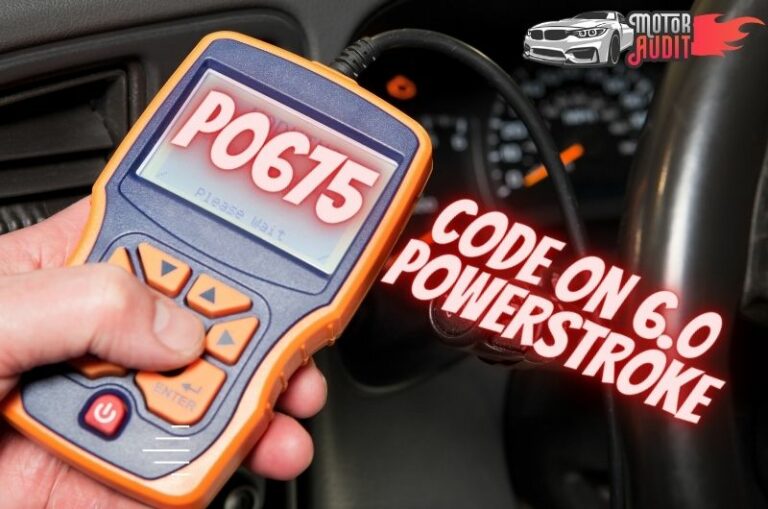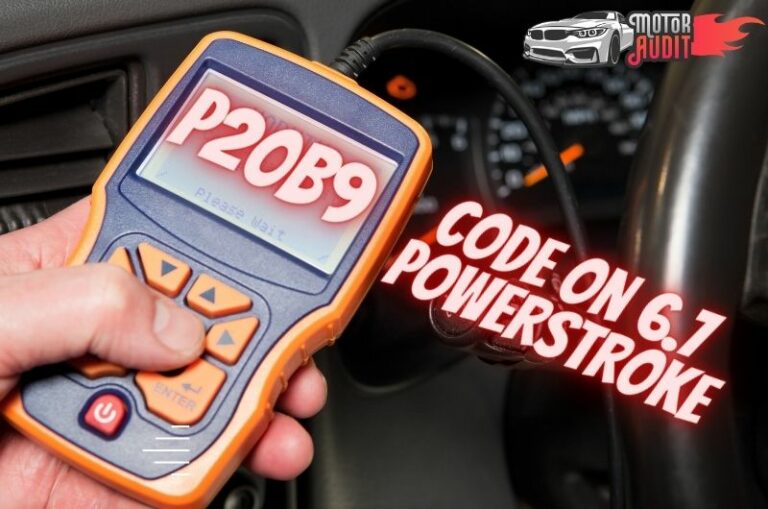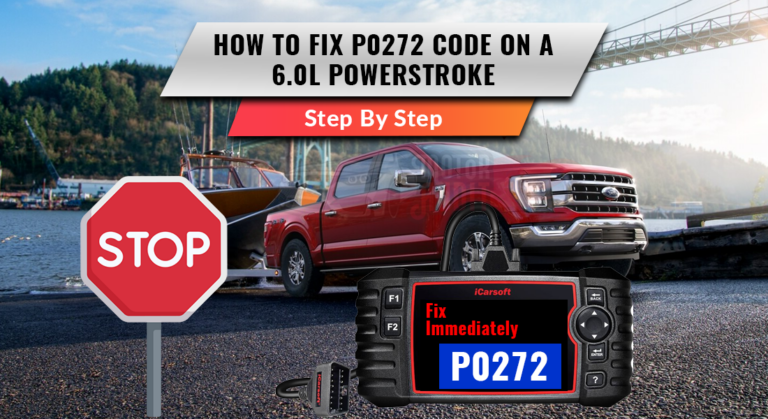Common 6.7 Powerstroke Fuel Filter Change Problems & Fix?
A fuel filter is a very necessary component of an ICE (Internal Combustion Engine) which removes any contaminants from the fuel. The fuel filter basically keeps the automobile running smoothly by not letting it get excessive damage from contaminants.
After the fuel filter change, the vehicle might take time to start because of no fuel supply to the engine. The fuel could be broken or face an irregular fuel gauge. These problems can create a harsh engine problem as well.
Once you face such problems after you have changed your fuel filter, it is natural to be worried about it. However, we will help you figure out the best way to deal with these fuel filter change problems and get rid of them accordingly.
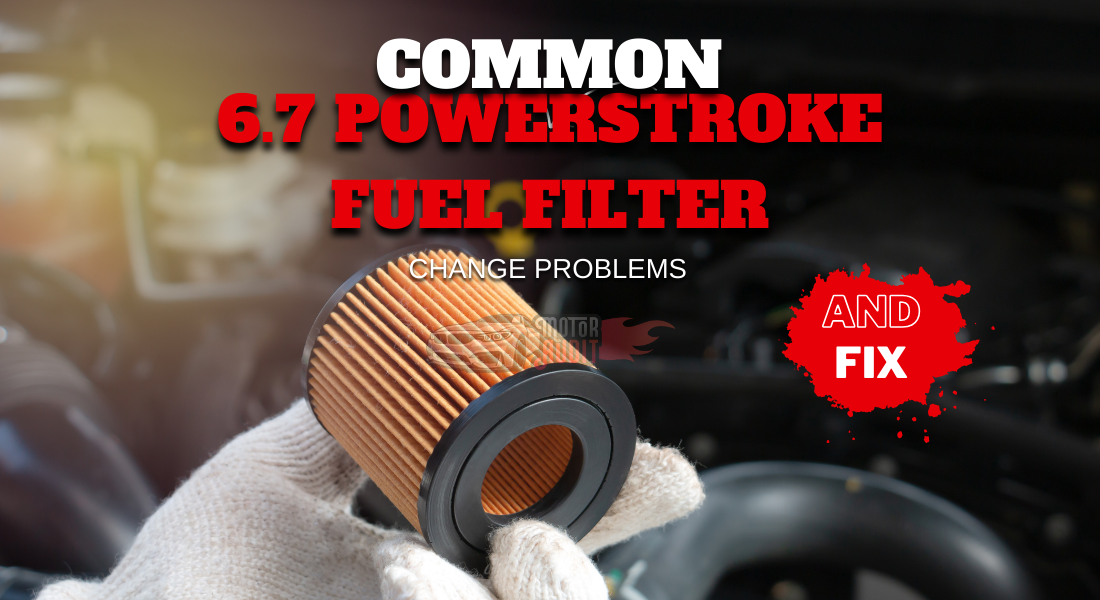
What Causes 6.7 Powerstroke Fuel Filter Change Problems?
The fuel filters need to be changed or replaced after a certain endurance range. At times, you will notice that the vehicle is facing some difficulties after you have routinely changed the fuel filters.
There could be very few reasons for the 6.7 powerstroke to face fuel filter change problems. The main reason behind this problem is usually a clogged fuel filter. Apart from that, some of the other causes behind your automobile facing a fuel filter change problem are-
- Incorrect fuel filter installment
- Reduced engine power due to no fuel supply
- Wrongly placed fuel filter adapter
- Irregular fuel gauge
4 Solutions For 6.7 Powerstroke Fuel Filter Change Problems
Now let’s get to know about the solutions and fixes for the fuel filter change problems mentioned above. The first thing you need to do in order to fix this problem on your vehicle is to diagnose which problem you are facing.
Check your fuel filter position, fuel adapter, fuel gauge and the fuel supply to pinpoint the actual problem. Then proceed to follow the solution for that specific faulty part.
Here are the solutions for the different causes of 6.7 Powerstroke fuel filter change problems:
1. Incorrect fuel filter installment: Change The Fuel Filter In The Proper Way
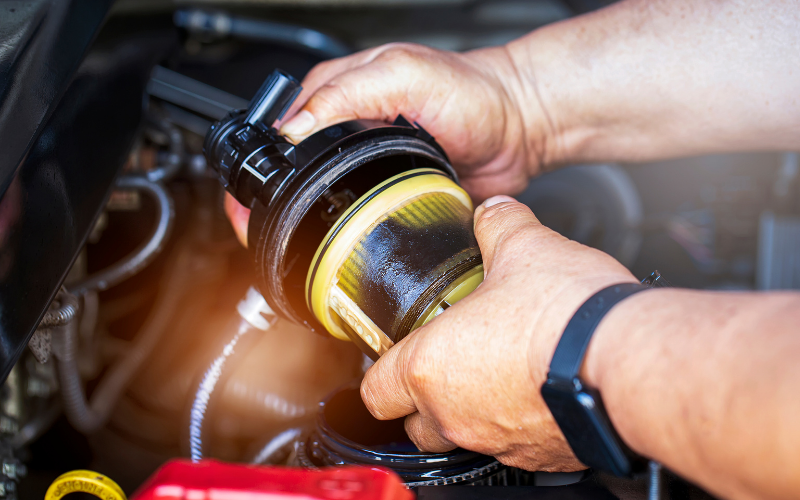
Suppose you are done with your fuel filter replacement for your car. However, you notice that the engine started running harshly afterwards. The reason behind this could be the misplacement in installing the fuel filter.
In order to fix this problem, you have to know the correct way to install a fuel filter. The process of changing the fuel filter properly is very simple. Here the steps you can follow to install the fuel filter in your automobile in the proper way:
- Firstly, locate the fuel filter. You will find it in the fuel line between the tank and the engine.
- Start your engine for 1-2 minutes to relieve the pressure inside the filter.
- Disconnect the negative battery terminal from the fuel lines.
- Loosen the clamps that hold the fuel filter in place with the help of a wrench.
- Unscrew the bolts and slide the old fuel filter off from the fuel lines.
- Use engine oil and lubricate the gasket of the new fuel filter first before installing it.
- Insert the new fuel filter into the housing properly.
- Tighten the previously loosened clamps on the fuel filter.
- Reconnect the negative terminals of the battery.
- Start the engine of the car and let the new fuel filter get to operating temperature to start working.
The engine should start running smoothly after this successful installation if the fuel filter was previously misplaced.
A new fuel filter will cost you around $100-$200. If you chose to do the replacement in an auto repair shop, the labor cost for this job can be anywhere between $10 to $70 depending on the location.
2. Reduced engine power due to no fuel supply: Adjust The Fuel Pressure Sensor
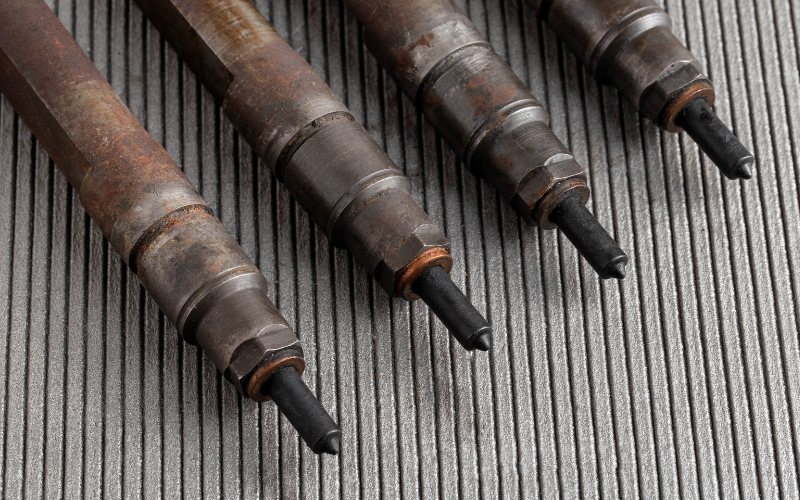
One of the most common problems after a fuel filter change can be the lack of fuel supply to the engine afterwards.
This can happen because of a low fuel pressure inside the fuel tank. As a result, even when you rest your car for less than 30 seconds, it faces a cranky start.
You will need to set a fuel pressure sensor for this problem with the correct volumetric fuel pressure on it. Follow these steps to adjust the correct PSI of the fuel pressure:
- Locate the fuel filter. You will find it in the fuel line between the tank and the engine.
- Disconnect the tube connected to the fuel filter. You will find it on the surface of the filter.
- Mount a good fuel pressure sensor on top of the fuel filter.
- Using a connector, connect the pipe to the fuel filter.
- Open the valves on top to let in some airflow.
- Check the specific automobile manual to know the allowed volumetric efficiency of the fuel.
- Set the fuel pressure to be around 60 and 80 PSI. It differs from model to model so, follow the manual’s instructions.
A new fuel pressure sensor can cost anywhere between $60-$100. The labor cost for this replacement can be $140 to $240. It might vary depending on location and car model.
3. Wrongly placed fuel filter adapter: Clear The Electricity Obstruction
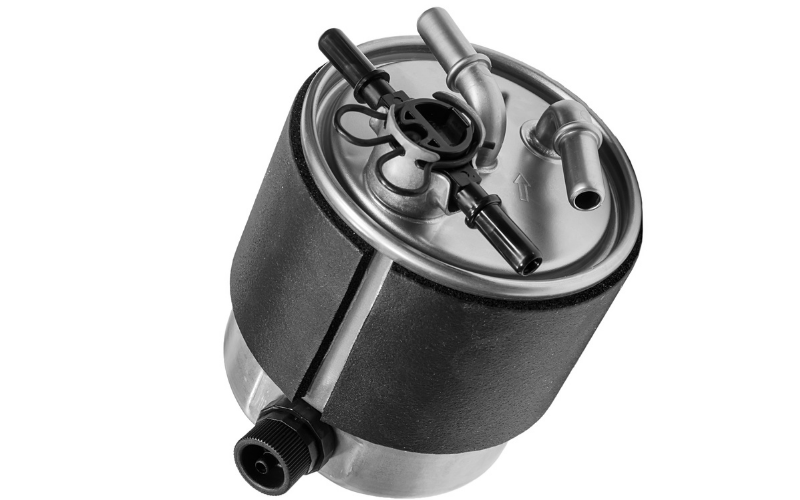
If you find that the adapter of the fuel filter is placed wrongly, it might be the reason for leakage from the container. An electrical cable will obstruct the path of the fuel filter. Therefore, the fuel filter can go to the motor or another way which is not correct.
To fix this problem, check all your components and parts connected to the fuel filter. Make sure no electrical cables are stuck in the way of the fuel line or the fuel filter line.
Next, check the circuit that regulates inside the fuel filter. Ensure that the circuit is receiving electricity through the car’s power source. If there is any cable or line blocking the circuit, connect the electrical components in the proper way following the instruction manual.
If you don’t have a fuel filter adapter and have to get a new one, it will be between $30 to $75. Usually, you won’t need to go into an auto repair shop for this fix so there would be no labor cost required either.
4. Irregular fuel gauge: Replace The Fuel Gauge
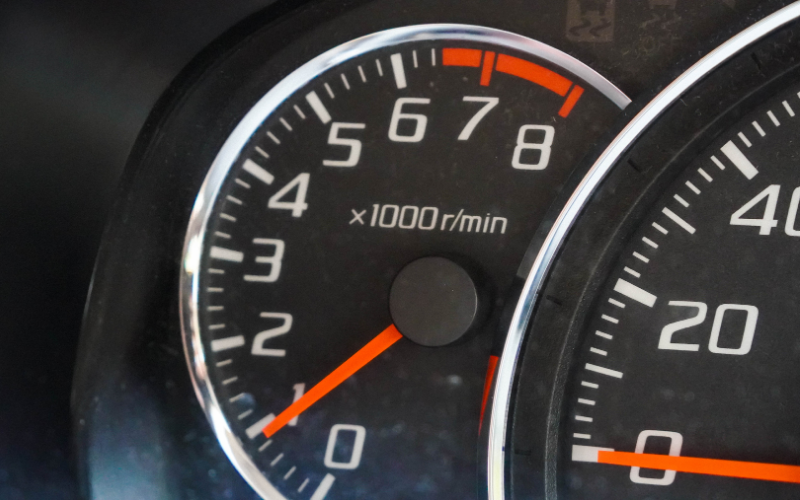
Sometimes you might notice your fuel gauge transmitting irregular signs after changing your fuel filter. The gauge might alternate between being blank or being filled for no reason. This can happen because of high heat and temperature transmitted from the fuel.
You can replace your fuel gauge to fix this issue. The best choice would be to go to a repair shop to get it done as it is a very difficult process. Here the steps you will need to follow in order to replace your fuel gauge:
- Park the car on a flat surface and palace chocks around the wheels.
- Open the hood of the car and disconnect the battery.
- Remove the fuel filler cap cable from the fuel filter.
- Get the fuel tank out of the vehicle.
- Clean the dirt and cracks around the area.
- Disassemble the fuel gauge and place a new one in its place.
- Test out the new fuel gauge with a multimeter to make sure it works properly.
- Reconnect all the disconnected wires and start the car to test drive.
Replacing the fuel gauge sender is the most expensive repair required for the 6.7 powerstroke fuel filter change problem.
The parts required for the replacement itself costs around $650 to $800. On top of that, the labor cost for this replacement is very high due to the difficulty of the job. It can range between $150-$300.
Frequently Asked Questions (FAQs)
In this part, we will cover some of the most frequently asked questions regarding the 6.7 powerstroke fuel filter change problems. Hopefully you will get the answer to your questions in this section.
When Should I Replace The Fuel Filter?
Any fuel filter of the car should be replaced after every 30,000 to 40,000 miles. It is possible to replace it after upto 150,000 miles as well.
However, for the smoothest functioning of the engine and proper fuel efficiency, it is better to replace the fuel filter after running 30,000 miles
What Are The Symptoms Of A Bad Fuel Filter?
You will see several symptoms once the fuel filter is changed and defects start showing up. Several such symptoms are-
Loss of engine power
Car starts to smoke while driving
Fuel pressure becomes low
Harsh engine
None or insufficient fuel supply
Can A Bad Fuel Filter Damage The 6.7 Powerstroke?
Yes, a bad fuel filter can cause average to serious damage to the 6.7 powerstroke. A bad fuel filter leads to contaminants in the fuel which runs to the engine. As a result, rust and corrosion will occur in the engine. It leads to poor engine performance and insufficient fuel economy.
How To Prevent A Clogged Fuel Filter?
You can keep your fuel filter unclogged and clean by cleaning the filter and fuel lines regularly. Use high quality fuel and avoid driving in too dusty and dirty roads often to keep the fuel filter clean enough. Remember to replace your fuel filter every 30,000 miles or less to avoid fuel filter problems in the future.
How To Clean The Fuel Filter Of A 6.7 Powerstroke?
To clean the fuel filter, firstly remove the filter from the car and disconnect the negative battery terminals. You need to spray pressurized carburetor cleaner inside the fuel filter to unclog it. Shake out any loose debris from the inside of the filter if needed and let it dry for a few hours.
Connclusion
In most cases, if you manage to successfully install the fuel filter without making any mistakes, there won’t be any problems showing up for a long time.
If the installation was successful but anything goes wrong, look at the other parts for the issue and then proceed as directed. It is recommended to contact a professional for the more difficult component fixes such as the fuel gauge replacement.
Remember to look at the section where the cost of the fixes are mentioned to get a clear idea of the required expenses. Choose the fix you can afford and get your car problems fixed to enjoy a smooth ride.
- Read Also>>P0263 6.0 Powerstroke: Cylinder Number 1 Produce Low Enegry
- Read Also>>P132B 6.0 Powerstroke: Turbochargers Boost Control ‘A’ Issue
- Read Also>>P1247 6.7 Powerstroke: Low Turbo Boost Pressure in Engine
- Read Also>>How To Fix TBC Fault Won’t Start Problem on 6.0 Powerstroke?
- Read Also>>4 Fix To 6.7 Powerstroke Fuel Rail Pressure Sensor Problems

